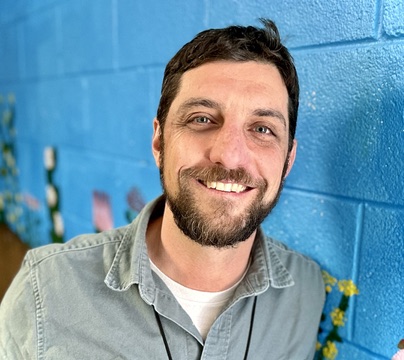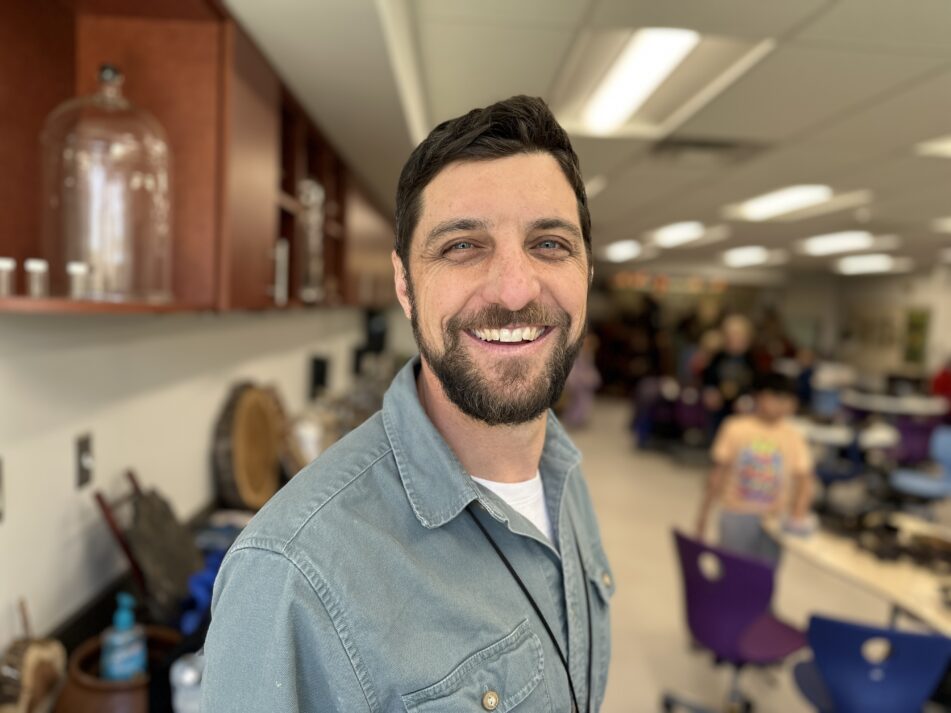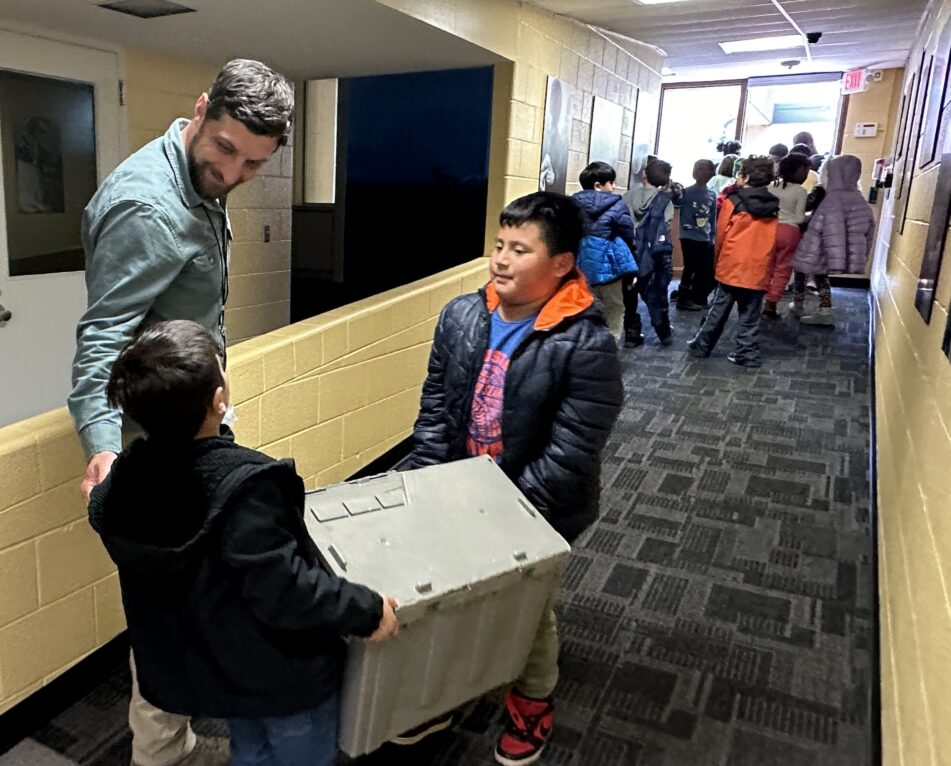

Coert Ambrosino is now in his sixth year serving as Environmental Education teacher for Ann Arbor Public Schools. Ambrosino is a product of AAPS (Abbot, Forsythe, Community, and Pioneer) and says his background in the community has proven to be a huge asset in his ability to interpret local environmental content for students throughout the school district.
Ambrosino did his undergraduate work at the University of Michigan in Latin American Studies and Environmental Studies, completing a senior thesis on the social and environmental impacts of monoculture pineapple production in Costa Rica after attending a semester abroad ecology program there. Ambrosino later returned to UM to earn his Masters’s degree in Elementary Education, with a student teaching internship at Mitchell Elementary.
Before joining the EE program, Ambrosino taught for 10 years in North Carolina, Colorado, and Michigan. During his teaching career, some of his professional accomplishments include facilitating district-level professional development series, co-authoring multiple academic articles, serving as a union rep, leading academic enrichment programming, and being honored with a Colorado statewide recognition award for exemplary teaching. He also has a rich background in camping, having spent nine summers working at camps in upstate New York and at Ann Arbor YMCA Camp Al-Gon-Quian in roles ranging from nature activity leader, to head counselor, to assistant director.
During his undergraduate years, Ambrosino worked for AAPS as a lunchtime supervisor and a bilingual tutor. Later, during his time teaching in Colorado, he would return in the summer to work in the SESLA program, serving as a lead teacher for multiple years. Ambrosino also served in a 2nd grade teacher role at Mitchell for a short stint, before moving into his current EE teaching position. Ambrosino believes that all of these past work experiences have prepared him for his varied and dynamic teaching role in the AAPS Environmental Education Program, in service of students of all ages across AAPS.
Ambrosino also currently serves as the adult liaison for the Freeman Environmental Youth Council and co-leads (along with Nate Hatt, A2STEAM PBL Coordinator) the Rec & Ed “A2 Nature Guardians” summer day camp at the Freeman Environmental Education Center.
Ambrosino is a lifelong learner who has completed professional development in NGSX, Project Wet, Master Rain Gardener certification, and the National Association for Interpretation’s Certified Interpretive Guide training. He is a member of the Michigan Alliance for Environmental and Outdoor Education and has earned his EE certification through its EEC-Professional program.
Part of Ambrosino’s job description was to move the Freeman Environmental Education Center into becoming an environmental hub for the community while accomplishing the Freeman Advisory Committee’s goals, says AAPS Environmental Education Consultant David Szczygiel.
“Immediately he was creating new lessons, working on building projects inside and out, and partnering with many local entities,” says Szczygiel. “I was swept away into many amazing projects at Freeman. He is even willing to listen to many stories as part of my institutional memory. Not only does he listen, but he begins to develop creative new plans, keeping the program memory as a guide. Much of the time he is so right on with new ideas, carrying me into new teaching realms.”
Szczygiel says Ambrosino is his favorite colleague of his entire career.
“He is so smart, enthusiastic, and energetic,” says Szczygiel, who is set to retire in a few weeks. “I found myself working on projects I never dreamed of doing due to Coert’s leadership and pervasiveness. I admired his ability to stay with a project, nudging people along, and leading stakeholders to commit to help facilitate the mission of bringing environmental education to the next generation.”
Ambrosino and his wife, Jordan, have two daughters, the elder of whom will start Kindergarten at Abbot Elementary in the fall. Favorite family activities include gardening, cooking, reading, hiking, and swimming at the lake. His family is trying the “1000 Hours Outside” challenge this year, though he jokes that if outdoor work hours are counted, he’ll hit that goal pretty quickly! Ambrosino’s other hobbies include volleyball, golf, woodworking, and native plant landscaping.

What would you most want people to know about your role as an environmental education teacher at AAPS?
I would highlight the aspect of partnership that we have with our amazing classroom teachers because I believe that this collaboration is crucial to the success and greater impact of EE field trips and lessons. We help ensure equitable access to annual, quality environmental field experiences for students across the district and we aim to make things easier on classroom teachers by providing trip preparation and pre-teaching materials, coordinating bussing and trip logistics, and scheduling trained volunteer naturalists to work with students in small groups. Classroom teachers play the important role of helping students draw connections with classroom lessons before, during, and after the trip. The best practice is to leverage the common learning experience for further classroom study, and teachers intentionally draw from questions generated during the field trip for research projects, integrate narrative or informational writing, or carry out other post-trip learning activities.
We also hope that by facilitating a guaranteed environmental field trip for each class and modeling best practices for outdoor learning that we inspire classroom teachers to integrate additional experiential learning opportunities into their classroom curriculum. Local environmental issues are highly engaging and authentic topics for students to explore, and they provide a powerful context for place-based, interdisciplinary learning. We all have a stake and a responsibility in developing environmental literacy skills in students, and an annual field experience provided by the EE Program is only one part of the puzzle.
I’d also encourage teachers and other district stakeholders to familiarize themselves with the goals in the AAPS Environmental Sustainability Framework. In the face of the climate crisis, I believe that successful implementation of the climate mitigation, adaptation, and education goals in this plan is crucial to the continued strength and success of our school district. Though the EE Program serves approximately 10,000 AAPS students each year, we currently just have two full-time teachers in our department and generally see students just once per year. It’s crucial that people across the district support the implementation of the sustainability framework in order to accomplish these robust and important goals.
Finally, I’d want people to know that I absolutely love getting to connect with so many incredible students, staff, community volunteers, and parent chaperones over the course of the year. It is quite an honor to serve the school district in this broad capacity.
What’s your favorite part of the job?
One thing I really love about this teaching role is the way that the outdoor lessons change with the seasons. Some of our programs, like 2nd Grade “Plant Communities” field trips and 3rd Grade “Habitat Studies” run in both Fall and Spring. The seasonal cycles create unique teaching opportunities, and it’s fun to adapt the lesson in response to the natural phenomena that students are gravitating to in the field, like reinforcing the concept of metamorphosis in the very moment a group of third graders watch a damselfly unfurl its wings for the first time during a spring pond trip.
It’s helpful to experience our field trip sites at different points in the year to better understand the biotic and abiotic factors, and to be able to interpret them for students. Seeing a vernal pool full of water and life in April allows you to notice and teach about the same dry, unassuming depression in the woodlot during an October “Habitat Walk” and the life cycles of the salamanders and fairy shrimp that miraculously make a living there.
The seasonality of our programming also helps me manage instructional materials (we use a lot of artifacts, visuals, and equipment) and become practiced at each grade-level lesson. And whenever I start to tire of a particular field trip, the calendar page always seems to turn and we’re on to a different set of lessons. When you layer seasonality on top of the huge variety of topics we teach, grade levels we serve, and natural areas that we utilize for programs, it makes for an ever-interesting teaching role that keeps you on your toes and allows for memorable learning experiences for students.

Do you remember field trips from your years as an AAPS student?
Yes, I have many fond memories of EE field trips with Bill Browning as a student. I remember touring the water treatment plant and visiting the Natural History Museum. I remember my “Winter Survival” field trip, which was located where Skyline High School now stands. I also recall a bus tour with Mr. Browning to study historical sites around the City of Ann Arbor. Of course, the lessons and field trips that the EE Program offers have evolved over the years in response to changes in classroom curriculum, state standards, staffing levels, site access, and community partnerships. I find enjoyment both in continuing longstanding field programs that I experienced as a kid and also in developing new lessons to address current needs and conditions.
What are some of the biggest challenges you face in getting kids excited and engaged about environmental topics? How do you overcome those challenges?
It can be challenging for a student to have a positive outdoor learning experience if they aren’t properly prepared and dressed for the weather. We utilize a variety of strategies to prepare classes for field activities, including teacher communications, pre-trip orientations, parent letters, and a public-facing website with a plethora of information about each grade-level program. Students learn valuable lessons about proper clothing/gear and safety strategies before, during, and after spending time outdoors in natural areas.
Can you share a fun or creative activity you do with kids to teach them about topics such as conservation, ecology, or sustainability in a hands-on way?
I enjoyed developing our “Keys to the Forest” high school field trip, which provides a hands-on introduction to tree identification and common forestry protocols. Students learn how to measure the diameter of trees and estimate their height and age. They observe the leaves, branching pattern, habit, fruit/seeds, and bark and use a dichotomous key to identify the species. In many cases, these have been completely novel learning experiences for students who have participated in this field trip over the past two years.
What advice would you give to parents who want to nurture their child’s curiosity and appreciation for nature from an early age?
Spend lots of time outside and encourage your child to slow down and notice the world around them. You might try simple observation activities like “I spy…” or sensory prompts like “I see, I hear, I smell, I feel…” Share wonderings and capitalize on questions your child has by making further observations or doing some research together. And utilize our amazing school and public library systems to expose your child to a variety of texts on these high-interest topics.
Have you noticed a difference in how receptive kids are to learning about the environment now versus when you first started teaching? What changes have you seen over time?
I’ve seen students express enthusiasm for learning about the natural world throughout my teaching career. I think everyone recognizes the cultural and technological trends that have resulted in more time spent indoors and on screens, and I cherish the experiential and multi-sensory learning experiences that we’re able to provide for students through EE field activities.
What is a memorable or impactful moment you’ve experienced while teaching kids about the environment during a field trip?
One moment that comes to mind is from a field trip to Rocky Mountain National Park with my fifth-grade class while I was teaching in Colorado. We were doing a teambuilding/outdoor recreation “camouflage” activity and I had a student who was easily getting spotted and called out because of the bright neon colors of the outfit he was wearing. This student had gone through some challenges throughout the year and hadn’t had many moments of positive recognition from peers. In the final round of the game, he had the intuition to hide amongst the class’ nearby pile of backpacks, popping up to win the game outright to great fanfare from his classmates. It was a sweet moment for the class and a point of pride for the student himself.
One of my favorite professors in my graduate program talked about the importance of “valuing the immeasurable” and thinking beyond the assessment data that we rely on so much as teachers to inform our instruction. There is research that indicates that high-quality environmental field experiences positively impact motivation, sense of place, and social-emotional well-being, in addition to student achievement. As someone who tends to focus mostly on the academic impact of our field trips, it is helpful to remember the range of learning outcomes that can arise from outdoor field experiences. I recognize and value the immeasurable gains that AAPS students make during environmental education field trips, practicing social and teamwork skills, self-regulation, wonder and appreciation for the natural world, and joyful moments.
What are a few of your favorite outdoor spaces in and around Ann Arbor?
What a privilege it is to live in a county with hundreds of accessible parks and natural areas. I frequent a variety of city, township, county, state, university, and metropark sites for field trips and for personal recreation. But here I’ll highlight the wonderful AAPS natural areas that our community can enjoy outside of school hours, including Scarlett-Mitchell Woods, Pioneer/Greenview, and Thurston Nature Center, among others.
You’ve worked around the country. Why did you return to your hometown?
Having grown up in Ann Arbor and attended UM (twice!), I am grateful to have had the chance to live in other parts of the country. The time I spent living and teaching in North Carolina and Colorado enriched my life and broadened my perspectives. My wife and I loved living in Denver and we miss the family and friends we have there. But Ann Arbor is an amazing place to live, and when our first child was on the way we decided to move home to where the grandparents (and one set of great grandparents!) live, and set down roots. We really appreciate the community that we have here, and the many natural and cultural resources that are unique to Ann Arbor and SE Michigan.
What do you like most about working with students from various grade levels throughout the district?
I remember last fall there was a stretch where I was leading field activities for AP Environmental Science classes and also teaching Young Fives lessons in the same week. I enjoy the challenge of adjusting my teaching to meet the needs of diverse learners, and I think that working with a variety of ages helps keep me attuned to the type of vocabulary, conceptual explanations, and learning activities that best fit with a specific audience. Teaching across a range of grade levels also helps me understand the scope and sequence of district curriculum and state standards, and to help students make connections to past learning experiences. And now in my 6th year in this role, there are students throughout the district who have participated in multiple field trips with me and it is awesome to see and support their development and environmental learning throughout their years in AAPS.



Favorite podcast/book/movie?
Choosing favorites is tough for me, but a recent read that I would recommend is All We Can Save: Truth, Courage, and Solutions for the Climate Crisis. It is an anthology of writings by 60 women who are doing climate work and I found it to be informative, devastating, and hopeful all at once.
What’s most exciting about your personal life right now? Your professional life?
One exciting thing at home is a plan to improve our main garden area over the summer. We’re planning to install some irrigation, prepare a new vegetable garden bed, and add an herb spiral and a rain garden. Projects like these encourage me and my family to be active and spend time outdoors, and they align with some of our home sustainability goals, like growing more food, managing stormwater, and increasing biodiversity.
One exciting thing at work is the upcoming Freeman Spring Environmental Festival, which will take place on May 18 from 1:00-3:30 pm at the Freeman Environmental Education Center! The event is being organized by the Freeman Environmental Youth Council and will be an afternoon of fun and educational activities, trivia, art, native plants, high school student presentations and more. All AAPS families are invited; elementary and middle school students should be accompanied by a parent/guardian. Dress for the weather, as there will be indoor and outdoor activities. Please RSVP here.


Be the first to comment